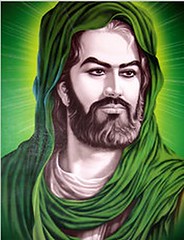There are two major strands of Islam - Sunni and Shia. The vast majority of the world's Muslims are Sunni. The name Shia is a contraction of Shiat Ali, the Party of Ali. Most of the population of Iran profess Shia Islam - it's the only country in the world with a majority Shia population, which isn't surprising, as this is the region in which Shia Islam emerged.
Imagine if Jesus had had a daughter and the Apostles had killed her offspring in order to retain control of the nascent Christian church; assuming you're a Christian or were brought up as such, that gives you an indication of the depth of the schism between Sunni and Shia Islam.
Despite inauspicious beginnings, the Prophet Muhammad became a rich and powerful man during his lifetime; he commanded armies and had access to vast wealth. He gathered around him a powerful cadre of followers, many of which were family. None of Muhammad's sons outlived him or reached adulthood, but one of his daughters, Fatima, did. Fatima was married to a cousin of Muhammad's named Ali and bore two sons, Hasan and Husayn.
After Muhammad's death, a power struggle emerged between his followers as to who should be his successor, or Khalifah (rendered in English as Caliph). Many of Muhammad's followers believed that the prophet's message should be passed on by his father-in-law, Abu Bakr. A smaller faction gathered around Fatima's husband, Ali.
Abu Bakr took the role of Caliph and a bitter feud broke out between to two factions, which lasted for years, Ali refusing to swear allegiance to Abu Bakr. Abu Bakr was followed as Caliph by Omar and Uthman.
Uthman was murdered in a violent uprising and Ali took control of the Caliphate after a protracted battle with Muawiyah, another of Muhammad's followers, a fierce warrior who commanded considerable armies.
Ali in turn was assassinated (and is now regarded by Shia as the first Imam) and replaced as Caliph by Muawiyah. The struggle for control of the Caliphate was taken up by Ali's son Hasan (grandson of Muhammad). Hasan was poisoned (becoming the second Shia Imam) and the fight fell to his brother Husayn, who fled with his extended family and supporters from Medina to Mecca and gathered support from the population of the town of Kufa, who had risen up in revolt against the hereditary succession established by Muawiyah and had requested Husayn to become their Imam.
Muawiyah's son Yazid had taken control of the Caliphate, suppressed the uprising at Kufa and took control of the city. Despite this, Husayn and just over one hundred of his followers started on the journey to Kufa, but were intercepted by the governor of Kufa and his army of between 30,000 and 200,000 men at Karbala, where the majority of the party were slaughtered, their remains left unburied and the women and children taken captive.
The battle of Karbala marked the decisive point at which Sunni and Shia Islam went their separate ways; the two grouping have never been reconciled since. The slaughter of Husayn (later designated the third Shia Imam) is commemorated every year in Iran at the festival of Ashura, the culmination of the mourning month of Moharram.
Subscribe to:
Post Comments (Atom)




1 comment:
Cheers for the background info Ben, very interesting stuff. Of the many things on my to-do list, I never got around to reading any Iranian history so this is a good intro. At some stage, how about the low-down on the Iranian Revolution, as they celerate it's 30th anniversary today.
Love the blog, and photos too.
Post a Comment